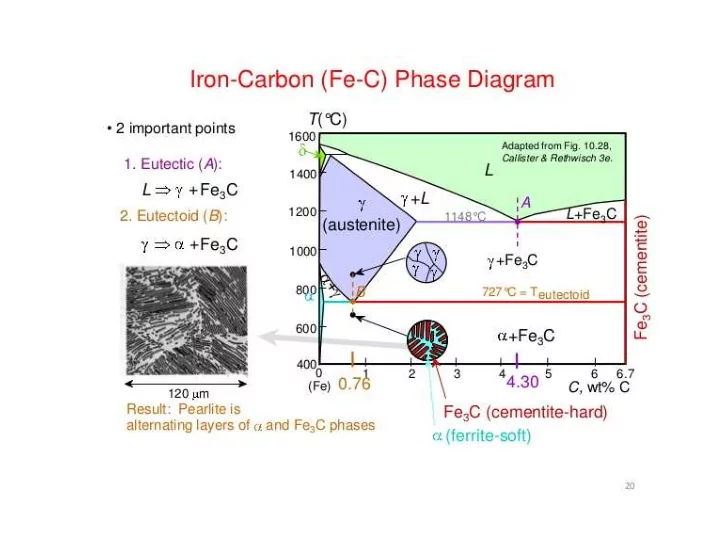

Strengthening of Steels • Presence of interstitial elements such as C and N. • Substitutional Elements like Mo, Nb • Heat Treatment – Annealing – Normalising – Quenching – Tempering • Grain Refinement • Cold working
Temperature Time Transformation Diagrams
TTT Diagrams – finer details
Example of 0.2% C Steel on Cooling
Lower Bainitic Structure
C % 0,02 0,2 0,4 0,8 1,2 Ms °C 520 490 420 250 150 Lathe martensite formed in 0,08 ° C Twinned martensite in Fe30%Ni steel quenched in brine from 100 ° C (x110000) (x20000), Ms in ° C = 561 - 474 (% C) - 33 (% Mn) - 17 (% Ni) - 17(% Cr) - 21 (% Mo).
Mechanical Properties of Normalized and Annealed Steels
Limit of Steels at High Temperatures • Mainly due to High Temperature Strength – Ferritic Structure – No strong Strengthening Mechanisms
Creep Strength as a function of temperature for various steels Temperature o C
Creep Strength of some Low alloy steels vs 304 SS
Ratios of RT tensile and Y.S of 21/4 Cr -1Mo steel as a function of Temperature UTS YS
HSLA • High Strength Low Alloy Steels • Mainly possess adequate strength and corrosion resistance • Main Alloying elements are Cr, Mo and Nb • Important Alloys are : – 21/4Cr-1Mo – economizer – 9Cr-1Mo – super heater • Modified 9Cr-1Mo-W and Nb for super critical power palnts for Tempertaure above 540 to 600 o C and Pressure about 100 bar.
Mechanism of Strength and Oxidation Resistance Strength comes from ISS – C SSS from Mo Secondary Carbides MoC 2 and lower Chromium carbide Corrosion resistance comes from Cr For 21/4Cr steels, the oxide scale is iron rich Cr spinel oxides and outer Fe 2 O 3 . For 9Cr steel, the scale is Cr-rich spinel tending toward chromium oxide
Heat Treatment The steels are used mostly in Normalized and tempered conditions. Normalization can form nuclei of carbide ppt, which on tempering result in uniform distribution and size which imparts strength. However time and temperature is very important. It is important not to form bulky carbides such as M 23 C or M 7 C
Tempering of 21/4Cr-1Mo steels
21/4 Cr-1Mo-V Steel
Micro Alloy Steels • Steels with 0.05 to 0.10% of elements such as Nb, Mo,Ti, W, Ta, V and/or B provide very high strength to the steel, with total concentration not exceeding 0.15%. • Use of Micro-alloy Steel in car bodies has helped in reducing the thickness of plate and thus has made them lighter. • The Yield Strength is [of the order of 500- 750 MPa.
Example of Micro alloyed Steels
Corrosion Resistance • At room temperatures – Organic paint Coatings – Galvanization – Electroplating • High Temperatures – Alloying – Mainly Cr – High Temperature coatings ?
Corrosion Resistance of Steels at Moderate Temperature applications • Usually steels are protected by modification of environment – by adding inhibitor Chemicals. • Ion exchange, adding of oxygen scavengers, phosphate treatment to control hardness and TDS. • Heat exchanger tubes are subjected to Hot conditioning – which is exposing them to steam for 24-48h to develop a magnetite layer. • Fire side corrosion problems are taken care by cladding or coatings with Ni-Cr alloys to save it from sulphidation and hot corrosion.
Recommend
More recommend